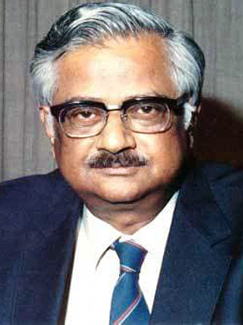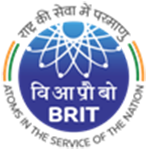Related Research Articles

Operation Smiling Buddha or Operation Happy Krishna was the assigned code name of India's first successful nuclear bomb test on 18 May 1974. The bomb was detonated on the army base Pokhran Test Range (PTR), in Rajasthan, by the Indian Army under the supervision of several key Indian generals.

Anushakti Nagar is the residential township of the Bhabha Atomic Research Center, Nuclear Power Corporation of India, Directorate of Construction Services and Estate Management, Atomic Energy Education Society in Mumbai, Maharashtra, India. Anu Shakti means atomic power in Sanskrit. Spread over more than 940 acres, this residential complex for the employees of Department of Atomic Energy of the Government of India in Mumbai, is situated in North-east Mumbai. Anushakti Nagar claims to be the largest scientific community in the world. It has the largest central library in the continent in Nuclear science and technology.

Raja Ramanna was an Indian physicist who is best known for his role in India's nuclear program during its early stages.

Homi Jehangir Bhabha, FNI, FASc, FRS, Hon.FRSE was an Indian nuclear physicist who is widely credited as the "father of the Indian nuclear programme". He was the founding director and professor of physics at the Tata Institute of Fundamental Research (TIFR), as well as the founding director of the Atomic Energy Establishment, Trombay (AEET) which was renamed the Bhabha Atomic Research Centre in his honour. TIFR and AEET served as the cornerstone of the Indian nuclear energy and weapons programme. He was the first chairman of the Indian Atomic Energy Commission and secretary of the Department of Atomic Energy. By supporting space science projects which initially derived their funding from the AEC, he played an important role in the birth of the Indian space programme.

The Bhabha Atomic Research Centre (BARC) is India's premier nuclear research facility, headquartered in Trombay, Mumbai, Maharashtra, India. It was founded by Homi Jehangir Bhabha as the Atomic Energy Establishment, Trombay (AEET) in January 1954 as a multidisciplinary research program essential for India's nuclear program. It operates under the Department of Atomic Energy (DAE), which is directly overseen by the Prime Minister of India.

The Homi Bhabha National Institute (HBNI) is an Indian deemed university established by the Department of Atomic Energy, which unifies academic programmes of several of its constituent institutions. Deemed universities in India have been divided in three categories by the Ministry of Human Resource Development (MHRD) and HBNI has been placed in category 'A', highest of the three categories. Homi Bhabha National Institute, Mumbai and its Constituent Units are the institutions of excellence as per section 4(b) of "The Central Education Institutions Act, 2006".
Ravi B. Grover is an Indian nuclear scientist and a mechanical engineer. He is the founding vice-chancellor of the Homi Bhabha National Institute, a member of the Atomic Energy Commission, chairman of the Board of Research in Nuclear Sciences, a fellow of the Indian National Academy of Engineering, and World Academy of Art and Science. He was the president of the Indian Society of Heat and Mass Transfer for the period 2010–2013. He has been awarded Padma Shri by the Government of India in the year 2014.

The Department of Atomic Energy (DAE) is an Indian government department with headquarters in Mumbai, Maharashtra, India. DAE was established in 1954 with Jawaharlal Nehru as its first minister and Homi Bhabha as its secretary.

Srikumar Banerjee was an Indian metallurgical engineer. He retired as the chairman of the Atomic Energy Commission of India (AECI) and the secretary of Department of Atomic Energy (DAE) on 30 April 2012. Prior to his stint as DAE chairman, he was the director of Bhabha Atomic Research Centre (BARC) from 30 April 2004 to 19 May 2010. He had also served as a DAE Homi Bhabha Chair Professor at Bhabha Atomic Research Centre, Mumbai. He was known as a great physical metallurgist.

The Raja Ramanna Centre for Advanced Technology is a unit of Department of Atomic Energy, Government of India, engaged in R&D in non-nuclear front-line research areas of lasers, particle accelerators and related technologies.
Padmanabhan Krishnagopala Iyengar, was an Indian nuclear physicist who is widely known for his central role in the development of the nuclear program of India. Iyengar previously served as the director of BARC and former chairman of the Atomic Energy Commission of India, he raised his voice and opposition against the nuclear agreement between India and the United States and expressed that the deal favoured the United States.

Board of Radiation and Isotope Technology in short known as "BRIT" is a unit of the Department of Atomic Energy with its headquarters in Navi Mumbai, India. Board of Radiation & Isotope Technology (BRIT), the unit of Department of Atomic Energy (DAE), is focused on bringing the benefits of the use of radio isotope applications and radiation technology across industry, healthcare, research and agricultural sectors of the society.

The Prime Minister's Office (PMO) consists of the immediate staff of the Prime Minister of India, as well as multiple levels of support staff reporting to the Prime Minister. The PMO is headed by the Principal Secretary, currently Pramod Kumar Mishra. The PMO was originally called the Prime Minister's Secretariat until 1977, when it was renamed during the Morarji Desai ministry.

Ratan Kumar Sinha, is an Indian nuclear scientist and mechanical engineer. He had served as the Secretary to the Government of India, Department of Atomic Energy (DAE) and Chairman of the Atomic Energy Commission (AEC), Government of India from April 2012 to October 2015. Prior to that, Ratan Kumar Sinha had served as Director of Bhabha Atomic Research Centre (BARC), Mumbai from May 2010 to June 2012. During the four decades of his career, Ratan Kumar Sinha held several important positions related to design & development of nuclear reactors for the Indian nuclear programme. He has been actively involved in the development of the advanced heavy water reactor (AHWR) and Compact High Temperature Reactor (CHTR), two of the highly acknowledged technological innovations which are suitable for large scale deployment of nuclear power, particularly in India.

Sekhar Basu was an Indian nuclear scientist who served as the chairman of the Atomic Energy Commission and Secretary to the Government of India, Department of Atomic Energy (DAE). He also served as the Director of Bhabha Atomic Research Centre (BARC), the Project Director of Nuclear Submarine Program, and later as the Chief Executive of the Nuclear Recycle Board at Bhabha Atomic Research Center. He was a recipient of India's fourth highest civilian honor Padma Shri in 2014.
Jai Pal Mittal is an Indian scientist, DAE Raja Ramanna Fellow of Bhabha Atomic Research Centre and Distinguished Professor of Indian Institute of Technology, Mumbai, the National Academy of Sciences, India and the University of Pune. He is known for his researches in the fields of photochemistry and radiation chemistry. He was honoured by the Government of India in 2003 with Padma Shri, the fourth highest Indian civilian award.
Satinder Kumar Sikka was an Indian nuclear condensed matter physicist, crystallographer and a former Scientific Secretary to the Principal Scientific Advisor of the Government of India. He was known to have played a crucial role, along with Raja Ramanna, Rajagopala Chidambaram and Basanti Dulal Nagchaudhuri, in the design and development of a Hydrogen Bomb by India, which was tested at the Pokhran Test Range in May 1998, under the code name, Operation Shakthi. He was also involved in the Smiling Buddha tests, conducted in 1974. He was awarded the fourth highest civilian award of the Padma Shri, by the Government of India, in 1999.
Dilip Devidas Bhawalkar is an Indian optical physicist and the founder director of the Raja Ramanna Centre for Advanced Technology (CAT), an institute under the Department of Atomic Energy, serving as a centre for higher studies in the fields of lasers and particle accelerators. He is credited with pioneering research in optics and lasers in India and is reported to have contributed in making CAT a partner in the International Linear Collider and Large Hadron Collider experiments of the European Organization for Nuclear Research (CERN). He is a recipient of the Shanti Swarup Bhatnagar Prize, the highest Indian award in science and technology. The Government of India awarded him the fourth highest civilian award of the Padma Shri in 2000.
Shyam Sunder Kapoor is an Indian nuclear physicist and a former director of Bhabha Atomic Research Centre. Known for his research on fission and heavy-ion physics, Kapoor is an elected fellow of all the three major Indian science academies – Indian Academy of Sciences, Indian National Science Academy and National Academy of Sciences, India – as well as the Institute of Physics. The Council of Scientific and Industrial Research, the apex agency of the Government of India for scientific research, awarded him the Shanti Swarup Bhatnagar Prize for Science and Technology, one of the highest Indian science awards, for his contributions to Physical Sciences in 1983.

Vasudeva Kilara Iya is an Indian nuclear scientist and the First Head of the radioisotope and radiation technology programme of the Department of Atomic Energy (DAE) and a former Group Director at BARC (1974-1987).
References
- ↑ Chandra, Bipan; Mukherjee, Aditya; Mukherjee, Mridula (2008). India Since Independence. Penguin Books India. p. 181. ISBN 978-0-14-310409-4.
- ↑ Chandra, Bipan; Mukherjee, Aditya; Mukherjee, Mridula (2008). India Since Independence. Penguin Books India. p. 310. ISBN 978-0-14-310409-4.
- ↑ "BARC Director K N Vyas appointed Atomic Energy Commission chief". Business Standard India. Press Trust of India. 18 September 2018.